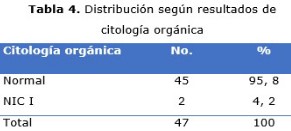Relationship between genital warts and cervical cancer precursor lesions in child and adolescent consultation
Abstract
Background: cervical cancer and genital warts share the same causative agent. The former is caused by high-risk oncogenic human papilloma virus, while the latter is generally caused by low-risk virus, though they are an important indicator of infection by high-risk virus. Persistence of the virus is essential to develop cervic cancer. Among the factors which favor the persistence are early age of first intercourse and sexually transmitted diseases. Adolescents are a vulnerable group.
Objective: to relate genital warts with cervical cancer precursor lesions in child and adolescent consultation.
Methods: a descriptive study was conducted whose universe included all patients with clinical diagnosis of genital warts who attended child and adolescent consultation at pediatric specialty clinic in Camagüey, from January 1 to December 31, 2014. Age groups, association with subclinical forms, acquisition factors, persistence the virus (sexual risk-taking behavior, tobacco consumption, prolonged usage of the combined oral contraceptive pill, cervicitis, and association with other sexually transmitted infections) were analyzed. Colposcopy was performed in those patients whose organic cytologies were abnormal. The information obtained was processed through SPSS-10 statistical program. Methods used were descriptive statistics of distribution of absolute and relative frequency. The study results were shown in tables.
Results: the most affected age group was 15 to 17 years and a sixth had subclinical infection. The majority had risky sexual behavior, and approximately the third presented associated sexually transmitted diseases. Almost the totality of organic cytologies was normal. Intraepithelial neoplasia grade I was detected with the presence of acetowhite epithelium in the colposcopy of nearly the eighth of the ill patients.
Conclusions: every adolescent patient with genital warts should undergo cytological examination and colposcopy. Furthermore, persistence factors of human papilloma virus should be identified.
DeCS:CONDYLOMATA ACUMINATA; UTERINE CERVICAL NEOPLASMS; SEXUALLY TRANSMITTED DISEASES; ADOLESCENT; EPIDEMIOLOGY, DESCRIPTIVE.
Downloads

Published
How to Cite
Issue
Section
License
Copyright: Camagüey Medical Archive Magazine, offers immediately after being indexed in the SciELO Project; Open access to the full text of the articles under the principle of making available and free the research to promote the exchange of global knowledge and contribute to a greater extension, publication, evaluation and extensive use of the articles that can be used without purpose As long as reference is made to the primary source.
Conflicts of interest: authors must declare in a mandatory manner the presence or not of conflicts of interest in relation to the investigation presented.
(Download Statement of potential conflicts of interest)
The Revista Archivo Médico de Camagüey is under a License Creative Commons Attribution-Noncommercial-No Derivative Works 4.0 International (CC BY 4.0).
This license allows others to distribute, to mix, to adjust and to build from its work, even for commercial purposes, as long as it is recognized the authorship of the original creation. This is the most helpful license offered. Recommended for maximum dissemination and use of licensed materials. The full license can be found at: https://creativecommons.org/licenses/












 22 julio 2025
22 julio 2025